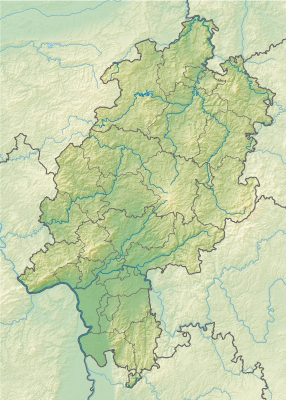Amöneburg Castle
| Amöneburg Castle | ||
|---|---|---|
|
Amöneburg castle ruins |
||
| Alternative name (s): | Mainz Castle (castrum maius) , Amöneburg Palace | |
| Creation time : | 1145 | |
| Castle type : | Hilltop castle | |
| Conservation status: | ruin | |
| Standing position : | Electoral | |
| Construction: | Basalt and sandstone | |
| Place: | Amöneburg | |
| Geographical location | 50 ° 47 '47 " N , 8 ° 55' 16.7" E | |
| Height: | 365 m above sea level NN | |
|
|
||
The area to the town Amöneburg belonging Burg Amöneburg (also called Main Zische Burg Amöneburg or earlier castle Amöneburg) a castle ruins about 16 kilometers east of Marburg in Marburg-Biedenkopf in Hessen . The name of the castle is derived from Amana , the medieval name of the Ohm .
location
The hilltop castle is at 365 m above sea level. NN. high mountain of the same name , a basalt dome that was formed about eight million years ago and belongs to a series of smaller volcanic chimneys , which are probably offshoots of the Vogelsberg . The mountain towers over the Amöneburg Basin by about 150 meters.
As with most volcanoes of this type, only minor basalt lava was extracted. Volcanic activity often began with gas explosions and the production of pyroclastic material . Only after this discharge did the basaltic lava flow out. There are meter-long basalt columns on the steep east face of the mountain.
The Ohm flows below the castle and is fed by the Rulfbach. Then the Ohm crosses the Amöneburg Basin.
history
A fortress already stood on the mountain in the time of the Merovingians . When Bonifatius began missioning the pagan-Christian population in and around the Amöneburg in 721, he used the Franconian fortress of Amöneburg as his domicile. A visible expression of his missionary work was the construction of a small monastery and a church within the castle complex. Like many early baptismal churches, the church was dedicated to the Archangel Michael .
In the Carolingian era, an extensive hilltop castle was built on the mountain. The location was favored by the proximity to important highways ( Lange Hessen , Weinstrasse ). From the 9th century the castle lost its importance.

In 1145 the Archdiocese of Mainz and its newly appointed burgrave Poppo von Reichenbach and Hollende built a new castle on the mountain top. In 1165 it was destroyed by Landgrave Ludwig von Thuringia on behalf of Emperor Friedrich I , but it was rebuilt immediately. The cause of the destruction was the support of the Archbishop of Mainz from Pope Alexander III .
A pledge to Kuno von Münzenberg is reported in 1183. In 1222 the castle was again occupied by Mainz Burgmanns and from 1273 the Amöneburg was the seat of the Mainz governor and thus the administrative center of the Upper Hessian possessions of the archbishopric.
During the Thirty Years' War the Amöneburg was occupied several times. In 1621 General Christian von Braunschweig-Wolfenbüttel captured the castle. On November 6, 1640 it was recaptured by imperial troops. On June 19, 1646, the castle was captured again and then destroyed by Hessian and Swedish troops under General Carl Gustav Wrangel . Between 1650 and 1675 the castle was partially renovated.
It was destroyed again in the Seven Years' War in 1762. In 1797 the castle hill was occupied in the First Coalition War. In 1839 the castle buildings were finally demolished because they were in disrepair. Today only the remains of residential buildings and parts of the curtain wall with flank towers can be seen.
investment

Remains of the keep , several cellars, outer walls of buildings and the spacious Zwinger with the outer towers have been preserved from the castle . The towers of the kennel have loopholes for firearms. Originally, the castle had a three-wing complex consisting of a long building, stable building and kitchen building, which was surrounded by a circular wall. The castle was connected to the city fortifications of the city of Amöneburg and was built from regional basalt . Window and door frames are made of sandstone .
The freely accessible castle ruins serve as the backdrop for the OpenEyes film festival every summer.
literature
- Michael Losse: The Lahn - castles and palaces. From Biedenkopf and Marburg via Gießen, Wetzlar and Weilburg to Limburg, Nassau and Lahnstein . Michael Imhof Verlag, Petersberg 2007, ISBN 978-3-86568-070-9 , pp. 43-45.
- Rudolf Knappe: Medieval castles in Hessen. 800 castles, castle ruins and fortifications. 3. Edition. Wartberg-Verlag, Gudensberg-Gleichen 2000, ISBN 3-86134-228-6 , pp. 246-247.
- Rolf Müller (Ed.): Palaces, castles, old walls. Published by the Hessendienst der Staatskanzlei, Wiesbaden 1990, ISBN 3-89214-017-0 , pp. 14-16.
Web links
- Entry by Jens Friedhoff zu Amöneburg in the scientific database " EBIDAT " of the European Castle Institute
- Amöneburg Castle on Burgenwelt.org
- Mainz Castle Amöneburg, Marburg-Biedenkopf district. Historical local lexicon for Hesse (as of June 12, 2014). In: Landesgeschichtliches Informationssystem Hessen (LAGIS). Hessian State Office for Historical Cultural Studies (HLGL), accessed on August 19, 2020 .
- Reconstruction drawing by Wolfgang Braun


